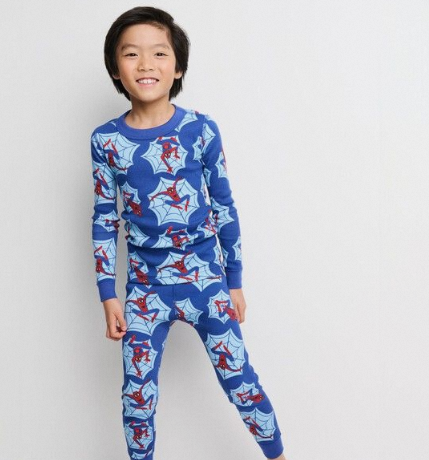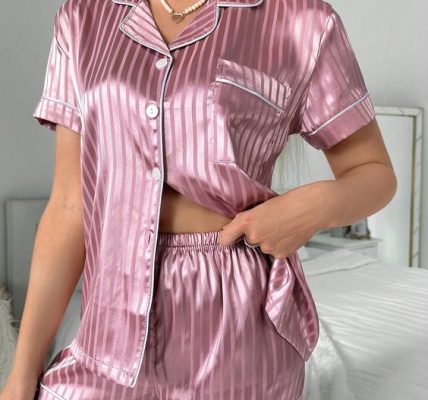The Origins of Men’s Sleepwear
Men’s sleepwear has a long and varied history. In ancient cultures, sleepwear was not much different from everyday clothing. Men often slept in the same garments they wore during the day. This was practical but did not offer special comfort or distinction between day and night attire.
During the Middle Ages, men’s sleepwear began to evolve. Nightshirts became the garment of choice. These were long pieces of clothing, often reaching down to the ankles. They provided warmth during cooler nights. The nightshirts were simple, loose-fitting, and made from linen or cotton.
The concept of specialized sleepwear emerged in the 17th century. More wealthy men started to wear bedgowns over their nightshirts. These bedgowns were often made of finer fabrics. They added a layer of luxury and comfort to men’s bedtime attire.

By the 19th century, the dressing gown was introduced. Men wore these over their nightshirts when lounging around the house before bedtime. The dressing gown added a sense of style and propriety to men’s sleepwear. It also marked a difference between private and public appearance.
As we venture into understanding the transformation of men’s sleepwear, it’s clear that comfort, functionality, and societal norms shaped its evolution. The shift from multipurpose garments to dedicated sleepwear reflects changes in lifestyle and attitudes towards leisure and relaxation. From functional nightshirts to stylish pajamas, men’s sleepwear has certainly come a long way.
From Nightshirts to Pajamas: A Style Transformation
The shift from nightshirts to pajamas marked a significant style transformation in men’s sleepwear. This change began in the early 20th century and reflects cultural shifts towards more comfort and privacy in the bedroom. In the early days, men’s pajamas consisted of a top and bottoms made from soft fabrics like silk and cotton. These sets offered more mobility and were considered more fashionable compared to their predecessors.
Pajamas introduced new features like buttons, collars, and cuffed sleeves. These elements added form and structure, moving away from the loose-fitting nightshirts. Patterns and colors also started appearing, making sleepwear a personal fashion statement.
This transition also signified a change in men’s attitudes towards their private lives. Pajamas suggested a more leisurely lifestyle and offered a different aesthetic for men’s bedtime routines. As a result, men began to pay more attention to the style of their sleepwear, choosing designs that reflected their tastes.
The adoption of pajamas also had practical reasons. They kept men warmer in winter and provided comfort in warmer seasons when made from lighter materials. As sleepwear evolved, the variety of available pajamas expanded, catering to different preferences and needs.
Pajamas have now become a staple in the realm of men’s sleepwear, continuing to evolve in terms of design, fabric, and convenience. It’s no surprise that this sleepwear revolution has paralleled changes in societal norms and lifestyles.
The Impact of Fabrics and Materials on Sleepwear Design
Choosing the right fabrics and materials is key in men’s sleepwear design. The fabric greatly influences comfort, durability, and maintenance of sleepwear. Historically, natural fibers like linen and cotton were the mainstays. They offered breathability and comfort, making them ideal for nightshirts and early pajamas.

As technology progressed, synthetic materials such as polyester and rayon became popular. They introduced benefits like wrinkle resistance and color retention. While these synthetics expanded design possibilities, they didn’t always provide the same comfort as natural fibers.
The texture and weight of the material also play a role. Heavier fabrics provide warmth in colder months, while lightweight materials like silk or fine cotton are perfect for warmer climates. The feel of the material against the skin is a crucial aspect of the design that affects the overall sleep quality.
In the quest for the ideal sleepwear, designers must balance aesthetics with functionality. Men’s sleepwear has seen the introduction of moisture-wicking fabrics and stretchable materials for added comfort. Advanced fabric treatments have also emerged, providing features like antibacterial properties and even built-in aromatherapy.
To conclude, the evolution of fabrics and materials has dramatically shaped men’s sleepwear design. It has transitioned from simple cotton nightshirts to high-tech, functional apparel that caters to modern needs and preferences.
Popular Men’s Sleepwear Styles Through the Decades
Men’s sleepwear has constantly evolved, reflecting both fashion trends and shifts in cultural attitudes. Let’s explore the popular styles that have characterized each decade.
1920s – Lounging Pajamas
In the Roaring Twenties, men’s sleepwear became fashionable. Lounging pajamas with exotic prints and silk fabrics emerged, echoing the era’s boldness and luxury.
1930s – Conservative Colors
The Great Depression influenced sleepwear to become more conservative. Darker colors and plainer designs in pajamas mirrored the times.
1940s – Utility and Durability
World War II necessitated practicality. Men’s sleepwear focused on durability and functionality, with simpler, utilitarian designs.
1950s – Matching Sets
Post-war affluence brought matching sets of pajamas. Classic patterns, like stripes and checks, offered a neat, put-together look that many men favored.

1960s – Casual Comfort
The ’60s saw a casual turn. Men relaxed in sleepwear made from comfortable, new synthetic fabrics like polyester, which were easy to care for.
1970s – Bold Patterns and Colors
Sleepwear got a splash of personality with vibrant colors and bold patterns, mirroring the decade’s flare for expressive styles.
1980s – Branded Sleepwear
The brand-conscious ’80s introduced sleepwear with logos. Popular culture and sports brands influenced men’s sleepwear trends.
1990s – Minimalist Trends
The minimalist movement of the ’90s saw men’s sleepwear adopt a more understated approach, with solid colors and less fuss.
2000s – Designer Touch
Entering the new millennium, designer brands elevated men’s sleepwear with high-quality fabrics and sophisticated designs, blending comfort with luxury.
2010s – Functional Fabrics
In the 2010s, the focus was on functionality. Advanced fabrics with moisture-wicking and anti-bacterial properties improved sleepwear performance.
As we journey through the evolution of men’s sleepwear, it is evident that each decade’s style mirrors broader societal changes. With comfort remaining a perennial priority, men’s sleepwear styles have continually adapted to the times.
Sleepwear and Masculinity: The Changing Perceptions
Sleepwear has long been tied to masculinity. In the past, perceptions of masculinity dictated sleepwear styles. Men’s sleepwear was simple and functional. The focus was not on fashion but on practicality. As time passed, these perceptions shifted.
In the mid-20th century, masculinity in sleepwear began to soften. Pajamas with patterns showed a new side to men’s fashion. Men embraced sleepwear that was both comfortable and expressive. This change reflected a broader societal acceptance of men taking pride in their appearance, even in the privacy of their home.
The late 20th century saw further changes. Men became more open to a variety of styles in sleepwear. No longer just a necessity, sleepwear became a way for men to express their personality. The introduction of luxurious materials like silk allowed for indulgence in comfort and style.
Today, the concept of masculinity is even more fluid. Men’s sleepwear includes a range of styles, from classic to bold. The modern man is free to choose sleepwear that suits his personal taste, without gender norms dictating his choice. Comfort and self-expression now go hand in hand when it comes to men’s sleepwear.
This evolution highlights the changing perceptions of masculinity in sleepwear. Comfort has become the cornerstone of modern men’s sleepwear. Style and self-expression are now seen as compatible with masculinity. As cultural attitudes continue to evolve, so too will the sleepwear that men choose to wear. The keyword “men’s sleepwear” has been at the center of this transformation, reflecting men’s evolving lifestyles and attitudes towards their private, leisurely selves.
The Influence of Pop Culture on Men’s Sleepwear
Pop culture deeply affects men’s sleepwear trends. From music icons to movie stars, their styles influence what men wear to bed. For instance, in the 1950s, celebrities like Elvis Presley brought attention to colorful and dynamic sleepwear looks. This trend caught on, and men started to seek sleepwear that matched their idols’ flashiness.

As television became more popular, characters from TV shows set sleepwear trends. For example, in the ’70s, the laid-back outfits worn by characters in sit-coms mirrored in sleeping garments. Men began to favor more relaxed and colorful pajamas inspired by these shows.
In the 90s and beyond, the rise of hip-hop culture saw bolder and oversized sleepwear become popular. Sports stars also contributed, with athletic-inspired sleep styles gaining traction. These trends emphasized comfort but also a sense of identity tied to favorite sports teams or music genres.
Blockbuster movies often set sleepwear fads too. Sci-fi successes introduced futuristic designs. Superhero franchises promoted sleepwear with logos and characters emblazoned on them. These pajamas allowed men to celebrate their fandom in their leisure time.
The internet age amplifies the influence of pop culture on men’s sleepwear. Social media platforms showcase influencer’s sleepwear styles and preferences. As men consume these digital trends, they quickly adapt their sleepwear choices. This connection has led to the rise of ‘loungewear,’ which blurs the lines between sleepwear and casual home attire.
In summary, pop culture plays a crucial role in shaping men’s sleepwear. It brings new styles and materials into the spotlight. As society’s taste in entertainment evolves, so does the men’s sleepwear seen in bedrooms across the world. The keyword ‘men’s sleepwear’ often crosses paths with the latest pop culture phenomena, emphasizing the ongoing link between what we enjoy in public and what we wear in private.
Modern Innovations in Men’s Sleepwear
The landscape of men’s sleepwear has seen a surge of innovation in recent years. Advances in technology and a push for personal comfort have led to remarkable changes. Below are key modern innovations that have transformed men’s sleepwear:
High-Tech Fabrics
Innovative fabrics now enhance the sleep experience. Moisture-wicking materials keep skin dry, while temperature-regulating fabrics adapt to body heat. These high-tech fabrics ensure a comfortable night’s sleep, no matter the climate.
Smart Sleepwear
The rise of smart textiles has brought sleepwear that can monitor sleep patterns and even adjust the sleeping environment. These garments use embedded sensors to gather data, which can aid in improving sleep quality over time.
Customizable Fit
Adjustable features such as elastic waistbands and drawstrings allow for a personalized fit. This customization enhances comfort and can accommodate changes in body size.
Aesthetic and Functional Design
Men’s sleepwear now balances style with practicality. Sleep sets come in a range of colors and patterns. They often include pockets and other functional elements without compromising the overall design.
Eco-Friendly Options
There’s a growing demand for sustainable men’s sleepwear. Brands are responding with options made from organic, renewable, and recycled materials. These eco-friendly choices reflect a commitment to the planet while still providing comfort and style.
The term ‘men’s sleepwear’ now encompasses a broad array of options, from the traditional to the cutting-edge. Embracing modern innovations, today’s sleepwear meets the demands of style, comfort, and sustainability.
Sustainable and Ethical Considerations in Sleepwear Fashion
Sustainable and ethical practices are becoming vital in the fashion industry, and men’s sleepwear is no exception. The rise of eco-awareness has placed importance on how sleepwear is made and the impact it has on the environment. Eco-friendly men’s sleepwear options are gaining traction as consumers seek to align their purchasing choices with their values.
Environmentally Responsible Materials
Brands are turning to materials that reduce environmental harm. Organic cotton, bamboo, and lyocell are popular for their low ecological footprint. These materials are renewable and often require less water and pesticides than traditional fabrics, making them better for the planet.
Fair Trade and Labor Practices
Ethical labor practices are crucial. Consumers support brands that ensure fair wages and safe working conditions for their workers. Transparency in the supply chain allows customers to make informed decisions about the ethics behind their sleepwear choices.
Longevity and Durability
Durable men’s sleepwear means less waste. Quality garments that last longer reduce the need for frequent replacements, which, in turn, cuts down on manufacturing demands and material waste. Men are encouraged to choose high-quality sleepwear that will stand the test of time.
Minimalist Design
The minimalist approach in men’s sleepwear favors simplicity and sustainability. Simple designs use less fabric and embellishments, which means less resource waste during production. This trend aligns with the ‘less is more’ philosophy and supports a more sustainable lifestyle.
Recycling and Upcycling
Recycling old garments is becoming more common. Sleepwear brands are introducing take-back programs and recycling initiatives. Upcycling transforms waste materials or unwanted products into new, useful items, including sleepwear. This reduces landfill waste and promotes a circular economy.
In conclusion, as men’s sleepwear evolves, sustainability and ethical considerations are increasingly at the forefront. Consumers and brands alike are embracing these values, ensuring that comfort does not come at the expense of the planet or its people. The keyword ‘men’s sleepwear’ now often carries connotations of responsibility and conscientious choice.




